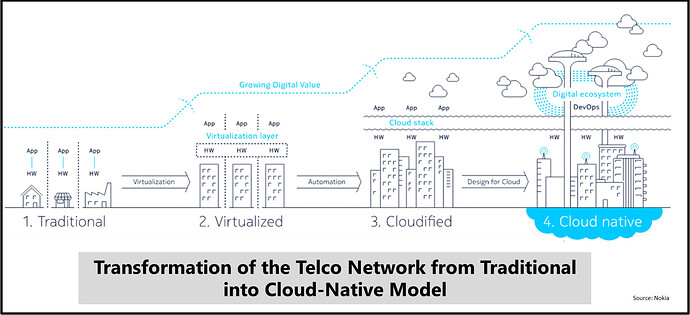How can we transform the Telco Network from Traditional into Cloud-Native Model?
-
My friend: Hi Ibrahim, I missed you during the last period and happy to see you again
 and as usual, I have a question for you.
and as usual, I have a question for you.- Me: I am happy to be with you again and I really missed your questions, so go ahead, I am waiting for it

- Me: I am happy to be with you again and I really missed your questions, so go ahead, I am waiting for it
-
My friend: I am hearing a lot about cloud-native but don’t understand what does it mean? And how we can make our telco architecture be a cloud-native?
- Me: Actually, we need to understand first where we are and how we can move towards the cloud-native model. So, the first step was using the traditional architecture, where CSPs bought specific HW components from vendors to do a specific function, like buying a HW to do the MME function in the 4G core, so this HW will be only MME and nothing else. And of course, the SW used in this MME is vendor-specific and can be used only over their HW, so this is the model which all operators started with.
-
My friend: So, what was the next step?
- Me: The next step was the virtualization and here we can run different applications (functions) on a generic HW unlike the traditional model where only one function can be run on specific HW. This leads to a better HW utilization and lower cost as generic HW can be used from different vendors and not a specific HW from a certain vendor. The apps are included inside what is called VNFs (Virtual Network Functions) which is one or multiple of VMs (Virtual Machines). So, HW will be divided into multiple parts, called VMs, using the virtualization layer, and so different functions can be created on the same HW. So, for example, we can have MME, SGW, and PGW over the same HW and not separate physical devices as in the traditional model.
-
My friend: Then the next step is cloud-native, right?
- Me: No, the next step is the cloudification and here we are trying to move the telco architecture to be deployed over the cloud by using the inherent features from the IT cloud such as automation, scaling, elasticity to cloudify the virtualized SW. So, multiple applications will run over generic HW in data centers.
-
My friend: So, the next step is …

- Me: Cloud-Native is the next and last step where the application architecture will be changed as it will be built to run over the cloud since the beginning, unlike the previous steps where the monolithic app can be used. So, for example, the apps will be designed since the beginning into small and independent pieces, so if you want to upgrade or do any operation task on any piece, the other pieces won’t be affected, this concept is called microservices. These microservices should run over containers. Cloud-native increases development speed and reusability and employs the CI/CD (Continuous integration/Continuous Delivery or Deployment) methodology and adopts the DevOps culture.
-
My friend: Thanks a lot.
- Me: You are welcome.
Linkedin: ![]()
